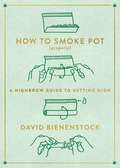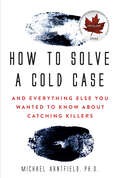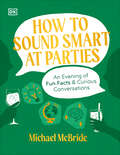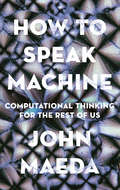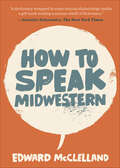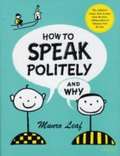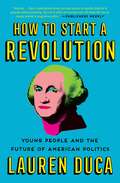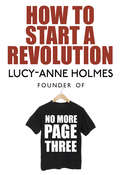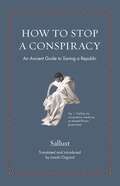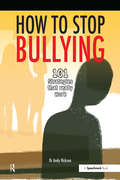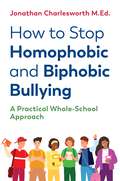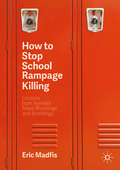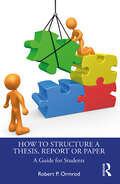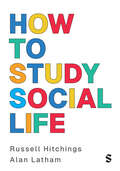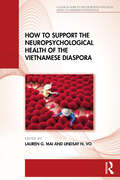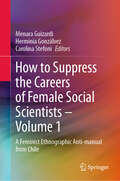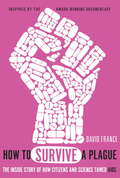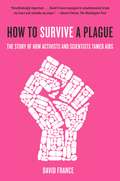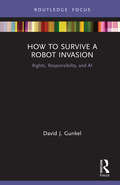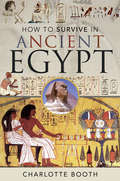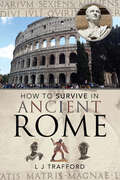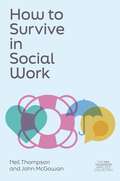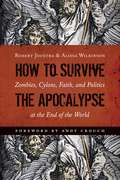- Table View
- List View
How to Smoke Pot (Properly): A Highbrow Guide to Getting High
by David BienenstockOnce literally demonized as "the Devil's lettuce," and linked to all manner of deviant behavior by the establishment's shameless anti-marijuana propaganda campaigns, cannabis sativa has lately been enjoying a long-overdue Renaissance. So now that the squares at long last seem ready to rethink pot's place in polite society, how, exactly, can members of this vibrant, innovative, life-affirming culture proudly and properly emerge from the underground--without forgetting our roots, or losing our cool?In How to Smoke Pot (Properly), VICE weed columnist and former High Times editor David Bienenstock charts the course for this bold, new, post-prohibition world. With plenty of stops along the way for "pro tips" from friends in high places, including cannabis celebrities and thought leaders of the marijuana movement, readers will learn everything from the basics of blazing, to how Mary Jane makes humans more creative and collaborative, nurtures empathy, catalyzes epiphanies, enhances life's pleasures, promotes meaningful social bonds, facilitates cross-cultural understanding, and offers a far safer alternative to both alcohol and many pharmaceutical drugs.You'll follow the herb's natural lifecycle from farm to pipe, explore cannabis customs, culture and travel, and discover how to best utilize and appreciate a plant that's at once a lifesaving medicine, an incredibly nutritious food, an amazingly useful industrial crop, and a truly renewable energy source. You'll even get funny and informative answers to burning questions ranging from: How can I land a legal pot job? to Should I eat a weed cookie before boarding the plane? In two-color, with charts and illustrations throughout, How to Smoke Pot (Properly) is truly a modern guide to this most revered herb. And remember, marijuana has the potential to help us live more meaningful, satisfying and authentic lives, and create safer, happier, more harmonious communities, but first we must learn to consume this miracle plant properly.From the Trade Paperback edition.
How to Solve a Cold Case: And Everything Else You Wanted To Know About Catching Killers
by Michael ArntfieldGet inside the mind of an elite cold case detective and learn how to solve a murder. Despite advances in DNA evidence and forensic analysis, almost half of murder cases in Canada and the US remain unsolved. By 2016, the solved rate had dropped so significantly in the United States that it was the lowest in recorded history, with one in two killers never even identified, much less arrested and successfully prosecuted. And the statistics are just as bad in Canada.As a sought-after global expert and former detective, Arntfield has devoted his career to helping solve cold cases and serial murders, including the creation of the Western University Cold Case Society, which pairs students with police detectives to help solve crimes. In How to Solve a Cold Case, Arntfield outlines the history of cold case squads in Canada and the US, and lays out the steps to understanding and solving crime. Arntfield shows you what to look for, how to avoid common mistakes, recognize patterns and discover what others have missed. Weaving in case studies of cold crimes from across Canada and the US, as well as a chapter on how armchair detectives can get involved, How to Solve a Cold Case is a must-read for mystery fans and true crime buffs everywhere.
How to Sound Smart at Parties: An Evening of Fun Facts & Curious Conversations
by Michael McBrideWelcome to the most interesting dinner party you&’ve ever attended!Join seven friends for an evening of trivia, myth-busting, and camaraderie. You'll have a front row seat at the party, listening in to the early small talk—where light and fun ideas are discussed (&“Did you know astronauts have Velcro on the inside of their helmets to scratch their noses?&”)—to the end of the night, when conversations get deeper. (&“Did the popularization of drinking coffee lead to modern democracies?&”)Packed with over 150 fun facts spanning the topics of ancient civilizations, animal behavior, natural science, outer space, human accomplishments, pop culture, and more, How to Sound Smart at Parties ensures you&’ll always have something clever to contribute to the conversation.
How to Speak Machine: Computational Thinking for the Rest of Us
by John MaedaVisionary designer and technologist John Maeda defines the fundamental laws of how computers think, and why you should care even if you aren't a programmer."Maeda is to design what Warren Buffett is to finance." --WiredJohn Maeda is one of the world's preeminent interdisciplinary thinkers on technology and design. In How to Speak Machine, he offers a set of simple laws that govern not only the computers of today, but the unimaginable machines of the future. Technology is already more powerful than we can comprehend, and getting more powerful at an exponential pace. Once set in motion, algorithms never tire. And when a program's size, speed, and tirelessness combine with its ability to learn and transform itself, the outcome can be unpredictable and dangerous. Take the seemingly instant transformation of Microsoft's chatbot Tay into a hate-spewing racist, or how crime-predicting algorithms reinforce racial bias.How to Speak Machine provides a coherent framework for today's product designers, business leaders, and policymakers to grasp this brave new world. Drawing on his wide-ranging experience from engineering to computer science to design, Maeda shows how businesses and individuals can identify opportunities afforded by technology to make world-changing and inclusive products--while avoiding the pitfalls inherent to the medium.
How to Speak Midwestern
by Edward McClelland&“A long-overdue study of the middle-American vernacular, and how that vernacular informs our identity . . . A regionally specific Urban Dictionary.&” —Inside Hook The Pittsburgh toilet. Squeaky cheese. City chicken. Shampoo Banana. Chevy in the Hole. These are all phrases that are familiar to Midwesterners, but foreign to anyone living outside the region. Find out what they mean in How to Speak Midwestern. Edward McClelland will not only explain what Midwesterners say, but how and why they say it. He examines the causes of the Northern Cities Vowel Shift, one of the most significant changes in English pronunciation in a thousand years; explains why the accents in Fargo miss the nasality that&’s a hallmark of Minnesota speech; and reveals why Chicagoans talk more like people from Buffalo than their next-door neighbors in Wisconsin. For outsiders, McClelland will include helpful information such as &“How to Talk Through Your Nose,&” &“How to Mispronounce Foreign Place Names,&” and &“&‘Well, That&’s Different&’: How to Passive-Aggressively Criticize People, Places and Things.&” If you&’re from the Midwest, you&’ll have a better understanding of why you talk the way you do. If you&’re not, well, you&’ll know exactly what to say the next time someone ends a sentence with &“eh?&” &“How to Speak Midwestern is a fascinating read, whether you hail from WOWOland, the UP, Cereal City, or Baja Minnesota.&” —Chicagoist &“A dictionary wrapped in some serious dialectology inside a gift book trailing a serious whiff of Relevance.&” —The New York Times
How to Speak Politely and Why
by Munro LeafThis children's book concisely explains which forms of grammar are the correct ones to use, and why.
How to Start a Revolution: Young People and the Future of American Politics
by Lauren DucaTeen Vogue award-winning columnist Lauren Duca shares a smart and funny guide for challenging the status quo in a much-needed reminder that young people are the ones who will change the world.A columnist at Teen Vogue, Lauren Duca has become a fresh and authoritative voice on the experience of millennials in today’s society. In these pages she explores the post-Trump political awakening and lays the groundwork for a re-democratizing moment as it might be built out of the untapped potential of young people. Duca investigates and explains the issues at the root of our ailing political system and reimagines what an equitable democracy would look like. It begins with young people getting involved. People like Alexandria Ocasio-Cortez, the youngest woman ever to be elected to Congress; David and Lauren Hogg, two survivors of the Parkland, Florida shooting who went on to become advocates for gun control; Amanda Litman, who founded the nonprofit organization Run For Something, to assist progressive young people in down ballot elections; and many more. Called “the millennial feminist warrior queen of social media” by Ariel Levy and “a national newsmaker” by The New York Times, Dan Rather agrees “we need fresh, intelligent, and creative voices—like Lauren’s—now as much—perhaps more—than ever before.” Here, Duca combines extensive research and first-person reporting to track her generation’s shift from political alienation to political participation. Throughout, she also draws on her own story as a young woman catapulted to the front lines of the political conversation (all while figuring out how to deal with her Trump-supporting parents).
How to Start a Revolution
by Lucy-Anne HolmesA bite-sized guide to making change happen and the story behind the No More Page 3 campaign, written by its founder. Change doesn’t just happen. It starts with the idea that something could be different, could be better. It starts with a person who is brave enough to stand up and say, ‘Stop.’ This is what Lucy-Anne Holmes did when she wrote a letter to the editor of The Sun asking him to stop printing pictures of topless women on Page 3 of the paper. This was something that had been happening for forty five years but which - she suddenly realised - she found outdated and inappropriate and, after thinking about it, not unrelated to a lot of the bad things that happen to women. Launching a digital campaign, starting an online petition and recruiting a team of like-minded people, Lucy-Anne started a revolution. Hundreds of thousands of people signed the petition, wore the campaign t-shirt and dared to say #NoMorePage3. Lucy-Anne had never campaigned on anything before. She wasn't particularly political. She'd never been confrontational. But she found that you only need one thing to start a campaign - and it isn't cash, experience or even a thick skin. It's passion.If you have a desire to change something, read what Lucy-Anne has to say. She’s been there, done that, worn the t-shirt and come out the other side having made a difference in the world.
How to Stop a Conspiracy: An Ancient Guide to Saving a Republic (Ancient Wisdom for Modern Readers)
by SallustAn energetic new translation of an ancient Roman masterpiece about a failed coup led by a corrupt and charismatic politicianIn 63 BC, frustrated by his failure to be elected leader of the Roman Republic, the aristocrat Catiline tried to topple its elected government. Backed by corrupt elites and poor, alienated Romans, he fled Rome while his associates plotted to burn the city and murder its leading politicians. The attempted coup culminated with the unmasking of the conspirators in the Senate, a stormy debate that led to their execution, and the defeat of Catiline and his legions in battle. In How to Stop a Conspiracy, Josiah Osgood presents a brisk, modern new translation of the definitive account of these events, Sallust’s The War with Catiline—a brief, powerful book that has influenced how generations of readers, including America’s founders, have thought about coups and political conspiracies.In a taut, jaw-dropping narrative, Sallust pleasurably combines juicy details about Catiline and his louche associates with highly quotable moral judgments and a wrenching description of the widespread social misery they exploited. Along the way, we get unforgettable portraits of the bitter and haunted Catiline, who was sympathetic to the plight of Romans yet willing to destroy Rome; his archenemy Cicero, who thwarts the conspiracy; and Julius Caesar, who defends the conspirators and is accused of being one of them.Complete with an introduction that discusses how The War with Catiline has shaped and continues to shape our understanding of how republics live and die, and featuring the original Latin on facing pages, this volume makes Sallust’s gripping history more accessible than ever before.
How to Stop Bullying: 101 Strategies That Really Work
by Andy HicksonThis book includes 101 tried-and-tested strategies to deal with bullying. This is a practical workbook full of information and ideas on how to stop being bullied. It contains 101 ideas grouped into five sections: practical and everyday ideas; longer term ideas; cyberbullying; fun ideas; and advanced techniques. In addition, there is information on creating and updating an anti-bullying policy, warm-up games and activities for groupwork, as well as stories of bullying and their resolutions. This is an extremely useful resource for people who get bullied, teachers, health care professionals and parents. Suitable for all ages. Andy Hickson is Director of Actionwork UK. Andy is a theatre Director and has had shows performed at the Globe, Sadlers Wells, Norwich Playhouse and many venues abroad. Andy specialises in using creative action methods to explore violence and other issues. Andy is also a filmmaker and was a runner-up in the 2008 Motorola film competition. Writing credits include Creative Action Methods in Groupwork which is translated into Polish and Japanese, and The Groupwork Manual (also published by Speechmark) and numerous articles and chapters. Andy is currently finishing off his PhD in education.
How to Stop Homophobic and Biphobic Bullying: A Practical Whole-School Approach
by Jonathan CharlesworthThis vital teachers' guide to challenging homophobic and biphobic bullying offers unique insights to address the issue at its core. With a renewed focus on a whole school approach, it builds capacity in those who work with young people and inspires an inclusive approach in every setting. Laying out clear advice on how to recognise, stop and prevent homophobic and biphobic bullying, readers are given strategies to work with its perpetrators, bystanders and targets. The author explains how to handle disclosures regarding sexual orientation and provides advice on effective Anti-Bullying Policy referencing homophobic and biphobic bullying. Based upon the work of the UK's leading and award-winning LGBT+ anti-bullying charity Educational Action Challenging Homophobia (EACH) this book additionally explores why young people are too often reluctant to report these forms of bullying; the increasing role of the online environment and the profound impacts bullying can have well into adulthood. Written by an expert in this field, this essential guide is for teachers, youth workers, the care sector and anyone with a duty of care towards young people.
How to Stop School Rampage Killing: Lessons from Averted Mass Shootings and Bombings
by Eric MadfisThis book tackles the important question of how we can understand and learn from the school rampage killings that have been prevented. In the flood of recent accounts and analyses of deadly school rampage killings that plague society and inspire widespread public fear, very little attention has been given to the incidents that almost were. Building on Madfis’ previous book, The Risk of School Rampage: Assessing and Preventing Threats of School Violence (2014), this vital work addresses key gaps in school violence scholarship through the examination of averted school rampage incidents in the United States and advances existing knowledge through ground-breaking insights from the latest research on mass murder, violence prevention, bystander intervention, disciplinary policy, and threat assessment in school contexts. This empirical study utilizes in-depth interviews conducted with school and police officials (administrators, counselors, security guards, police officers, and teachers) directly involved in averting potential school rampages to explore the processes by which threats are assessed and school rampage plots are thwarted. Madfis finds that many common contemporary school violence prevention policies and practices are ineffective at preventing rampage attacks and may actually increase the likelihood of their occurrence. Rather than uncritically adopting such problematic approaches, Madfis argues that schools must model prevention practices upon what has proven successful in averting potentially deadly incidents.
How to Structure a Thesis, Report or Paper: A Guide for Students
by Robert P. OrmrodHow to Structure a Thesis, Report or Paper provides concise practical guidance for students to help make their writing more structured at any level. It assists students in demonstrating what they have learned in the relevant course or degree programme in a way that is accessible to the supervisor and the examiner. Drawing on almost 20 years of supervision experience, the author presents the eight sections of a well-structured thesis, report or paper, together with discussing other relevant issues. Each chapter provides a detailed description of why each section of a thesis, report or paper is structured in the way it is, and its relationship to the whole piece of work. Good and bad examples are provided throughout the book, and there is a focus on key areas such as the six parts of an Introduction and its relationship to the Conclusion, how to phrase clear research questions and hypotheses to the use of references and how to make the thesis, report or paper easier to read. The structure presented in this book can be used to support many courses on the student’s entire degree programme, as the structure can be adapted by re-arranging or deleting sections. This book is an invaluable aid to students at all stages in higher education, from their first report or paper until they write their final thesis. It provides clear guidelines for when students should ask their supervisors for advice, and when students can use their own initiative to learn the most. It makes writing a thesis, report or papers more straightforward!
How to Study Social Life
by Russell Hitchings Alan LathamDo you want to study what people do, the things they say, or what they think? This book offers a lively and questioning account of the essential elements of social research, from defining your research purpose to producing the right output for your audience. Fostering inquisitiveness and ingenuity and drawing on lots of examples and experiences, it will inspire you to think afresh about the various things you might do as a social researcher. It will also: Reveal the lived realities of research, sharing honest and illuminating stories along the way; Draw on plenty of past exercises with students to consider how different activities work Demystify the process so you can think for yourself about how to do effective projects. Original, engaging and candid, this book will help any undergraduate or postgraduate navigate the dynamic and challenging landscape of social research with confidence and creativity.
How to Study Social Life
by Russell Hitchings Alan LathamDo you want to study what people do, the things they say, or what they think? This book offers a lively and questioning account of the essential elements of social research, from defining your research purpose to producing the right output for your audience. Fostering inquisitiveness and ingenuity and drawing on lots of examples and experiences, it will inspire you to think afresh about the various things you might do as a social researcher. It will also: Reveal the lived realities of research, sharing honest and illuminating stories along the way; Draw on plenty of past exercises with students to consider how different activities work Demystify the process so you can think for yourself about how to do effective projects. Original, engaging and candid, this book will help any undergraduate or postgraduate navigate the dynamic and challenging landscape of social research with confidence and creativity.
How to Support the Neuropsychological Health of the Vietnamese Diaspora (A Clinical Guide to the Neuropsychological Health of Immigrant Populations)
by Lauren G. Mai Lindsay N. VoHow to Support the Neuropsychological Health of the Vietnamese Diaspora is the first book in a new series entitled A Clinical Guide to the Neuropsychological Health of Immigrant Populations, which guides clinicians in the art and science of providing culturally competent services to specific communities. Grounded in evidence-based research and clinical experience, the book offers a better understanding of the unique problems and experiences that the Vietnamese population share, along with examples of how to navigate cultural differences in the assessment and treatment of cognitive impairment.The book reviews the sociocultural and historical factors relevant to those of Vietnamese descent, which help to conceptualize individuals' presentations, common socio-cultural considerations for assessment or treatment, and literature related to working with this population in an international and medical context. It also offers current practice guidelines or approaches to assessment and intervention, along with case studies, a glossary of the necessary cognitive science terms in Vietnamese, and practical resources.It is essential reading for clinicians in the patient care setting, as well as students and researchers in clinical neuropsychology and related fields of psychology, sociology, medicine and forensics.
How to Suppress the Careers of Female Social Scientists – Volume 1: A Feminist Ethnographic Anti-manual from Chile
by Menara Guizardi Herminia Gonzálvez Carolina StefoniThis book is the first of a series of five volumes that analyze and denounce the gender inequalities and violence faced by Latin American female social scientists in academic settings. The five volumes will present and discuss the results of an ethnographic research project conducted in four countries – Argentina, Brazil, Chile, and Mexico – to analyze gender inequalities experienced by Latin American women in five dimensions of academic life: undergraduate education, graduate education, labor insertion, professional performance in stable positions, and gender violence faced at work. This first volume narrates the creation of the research project, from the formulation of its methodological strategy to the application and analysis of its first case study in Chile. It presents the theoretical-methodological perspective adopted in the whole project – a feminist ethnography that draws on the intersubjective role of female experiences to denounce situations of power inequality – and analyses the testimonies of 50 female academics working in 12 universities in nine cities of Chile. The title of the five-volume set, How to Suppress the Careers of Female Social Scientists, pays homage to the seminal work of Joanna Russ about gender inequalities faced by female writers, How to Suppress Women’s Writing, and this first volume is both a "manual" and an "anti-manual". On the one hand, the first two parts of the book serve as a "manual" that situates the Chilean case, clarifies the methodological construction of the research project and discusses the limitations and possibilities of feminist methodologies in the social sciences. On the other hand, the third and fourth parts of the book are ironically presented as an “anti-manual” that explain how the careers of female social scientists are destroyed by intersectional gender-based inequalities and violence, even in social contexts that are open to equity policies.
How to Survive a Plague: The Inside Story of How Citizens and Science Tamed AIDS
by David FranceFrom the creator of the seminal documentary of the same name, an Oscar finalist, the definitive history of the successful battle to halt the AIDS epidemic, and the powerful, heroic stories of the gay activists who refused to die without a fight.Shortly after David France arrived in New York in 1978, the newspaper articles announcing a new cancer specific to gay men seemed more a jab at his new community than a genuine warning. Just three years later, he was reporting on the first signs of what would become an epidemic. Intimately reported, suspenseful, devastating, and finally, inspiring, this is the story of the men and women who watched their friends and lovers fall, ignored by public officials, religious leaders, and the nation at large. Confronted with shame and hatred, they chose to fight, starting protests, rallying a diverse community that had just begun to taste liberation in order to demand their right to live. We witness the founding of ACT UP and TAG (Treatment Action Group), the rise of an underground drug market in opposition to the prohibitively expensive (and sometimes toxic) AZT, and the gradual movement toward a lifesaving medical breakthrough. Throughout, France's unparalleled access to this community immerses us in the lives of extraordinary characters, including the closeted Wall Street trader turned activist; the prominent NIH immunologist with a contentious but enduring relationship with ACT UP; the French high school dropout who finds purpose battling pharmaceutical giants in New York; and the South African physician who helped establish the first officially recognized buyers' club at the height of the epidemic. Expansive yet richly detailed, How to Survive a Plague is an insider's account of a pivotal moment in the history of civil rights.
How to Survive a Plague: The Inside Story of How Citizens and Science Tamed AIDS
by David France<p>The definitive history of the successful battle to halt the AIDS epidemic--from the creator of, and inspired by, the seminal documentary How to Survive a Plague. <p>A riveting, powerful telling of the story of the grassroots movement of activists, many of them in a life-or-death struggle, who seized upon scientific research to help develop the drugs that turned HIV from a mostly fatal infection to a manageable disease. Ignored by public officials, religious leaders, and the nation at large, and confronted with shame and hatred, this small group of men and women chose to fight for their right to live by educating themselves and demanding to become full partners in the race for effective treatments. Around the globe, 16 million people are alive today thanks to their efforts. <p>Not since the publication of Randy Shilts's classic And the Band Played On has a book measured the AIDS plague in such brutally human, intimate, and soaring terms. In dramatic fashion, we witness the founding of ACT UP and TAG (Treatment Action Group), and the rise of an underground drug market in opposition to the prohibitively expensive (and sometimes toxic) AZT. We watch as these activists learn to become their own researchers, lobbyists, drug smugglers, and clinicians, establishing their own newspapers, research journals, and laboratories, and as they go on to force reform in the nation's disease-fighting agencies. <p>With his unparalleled access to this community David France illuminates the lives of extraordinary characters, including the closeted Wall Street trader-turned-activist, the high school dropout who found purpose battling pharmaceutical giants in New York, the South African physician who helped establish the first officially recognized buyers' club at the height of the epidemic, and the public relations executive fighting to save his own life for the sake of his young daughter. <p>Expansive yet richly detailed, this is an insider's account of a pivotal moment in the history of American civil rights. Powerful, heart-wrenching, and finally exhilarating, How to Survive a Plague is destined to become an essential part of the literature of AIDS.</p>
How to Survive a Robot Invasion: Rights, Responsibility, and AI
by David J GunkelIn this short introduction, David J. Gunkel examines the shifting world of artificial intelligence, mapping it onto everyday twenty-first century life and probing the consequences of this ever-growing industry and movement. The book investigates the significance and consequences of the robot invasion in an effort to map the increasingly complicated social terrain of the twenty-first century. Whether we recognize it as such or not, we are in the midst of a robot invasion. What matters most in the face of this machine incursion is not resistance, but how we decide to make sense of and respond to the social opportunities and challenges that autonomous machines make available. How to Survive a Robot Invasion is a fascinating and accessible volume for students and researchers of new media, philosophy of technology, and their many related fields. It aims both to assist readers’ efforts to understand a changing world and to provide readers with the critical insight necessary for grappling with our science fiction-like future.
How to Survive in Ancient Egypt
by Charlotte BoothWhat would it be like if you were transported back to Thebes, 1360 BCE? This time-traveler’s guide is a fascinating way to find out . . . Imagine you were transported back in time to Ancient Egypt and you had to start a new life there. What would you see? How would the people around you think and believe? How would you fit in? Where would you live? What would you eat? Where would you go to have your hair done, or get help if you got ill or were mugged in the street? All these questions, and many more, are answered in this engaging blend of self-help and survival guide that plunges you into this historical environment—and explains the many problems and strange new experiences you would face if you were there.
How to Survive in Ancient Rome
by L J TraffordWhat you’d need to know if you time-traveled to Ancient Rome—from local customs to clothing to religion to housing to food.Imagine you were transported back in time to Ancient Rome and you had to start a new life there. How would you fit in? Where would you live? What would you eat? Where would you go to have your hair done? Who would you go to if you got ill, or if you were mugged in the street? All these questions, and many more, are answered in this new how-to guide for time travelers. This lively and engaging twist on ancient history reveals how to deal with the many problems and new experiences you would face—and thrive in this strange new environment.
How to Survive in Social Work (The Neil Thompson Practice Collection)
by Neil Thompson John McGowanSocial worker. You're a helping hand, a rock in the tempest, a friendly face through the hard times, and a catalyst for change. But what about you? How do you keep going when the pressure just keeps rising?In this no-nonsense handbook, Neil Thompson and John McGowan distil years of social work expertise into key strategies to overcome the challenges that come with the profession. Each chapter is full of clear, practical advice on staying resilient in the face of tough situations, whether they're political, social, or economic. Handy frameworks and expert advice will strengthen your practice and give you a solid structure to build on, helping you fulfil your potential as a social worker and provide better support for your clients. Social work is tough, but with the guidance and support in this book you can learn to tackle the challenges and thrive as a force for change.
How to Survive the Apocalypse: Zombies, Cylons, Faith, and Politics at the End of the World
by Robert Joustra Alissa WilkinsonIncisive insights into contemporary pop culture and its apocalyptic bent. The world is going to hell. So begins this book, pointing to the prevalence of apocalypse — cataclysmic destruction and nightmarish end-of-the-world scenarios — in contemporary entertainment. In How to Survive the Apocalypse Robert Joustra and Alissa Wilkinson examine a number of popular stories — from the Cylons in Battlestar Galactica to the purging of innocence in Game of Thrones to the hordes of zombies in The Walking Dead — and argue that such apocalyptic stories reveal a lot about us here and now, about how we conceive of our life together, including some of our deepest tensions and anxieties. Besides analyzing the dsytopian shift in popular culture, Joustra and Wilkinson also suggest how Christians can live faithfully and with integrity in such a cultural context.
How to Survive the End of the World
by HowstuffworksFrom the creative editorial minds at HowStuffWorks.com comes a volume of entertaining advice to help readers survive the end of the world as we know itIn response to our readers, who are particularly curious about both doomsday scenarios and survivalist techniques, HowStuffWorks.com presents Surviving the End of the World. There are many possible ends in store for our world. Zombie hordes could rise up and eat our brains. A viral pandemic could sweep the globe, decimating the human population but for a hearty, immune few. Or a catastrophic solar superstorm might render all electronics on the planet inert, causing a civilization-ending panic. You won't survive hanging around the dead, the near-dead, or the undead, so in case of Armageddon, head for the hills. Perhaps you're being chased and leave with nothing but a machete and your will to live. Perhaps you actually have time to pack, but you aren't sure what you might need. Once you're in the wilderness, how will you cope? This volume will advise you on such subjects as building shelter in the forest with your bare hands, hunting edible berries in the summer and edible termites year-round, and avoiding the critical stages of dehydration. We even include tips on making moonshine and chocolate, since you'll need something to sweeten the New World Order. If the world as we knew it came to an end, we'd like to think we'd survive. At least, we'd like to think that this book, with its equal parts education and laughter, gives our readers an advantage. Join us for the apocalypse. Let's survive together.
